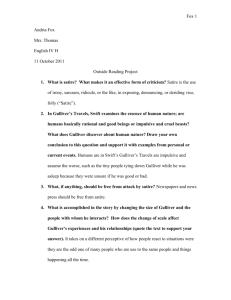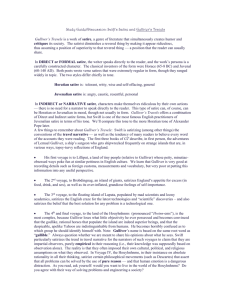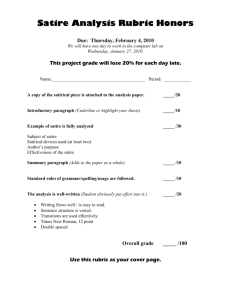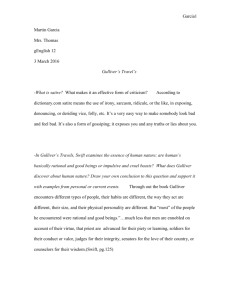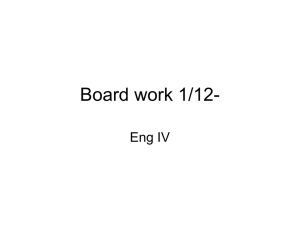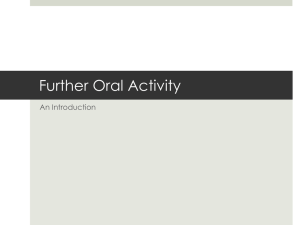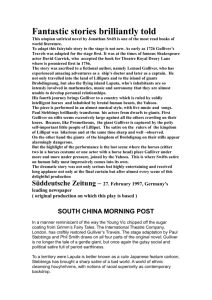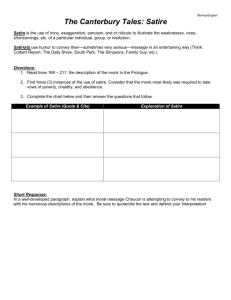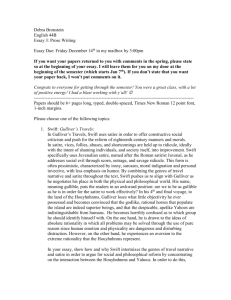gullivers_travels-
advertisement
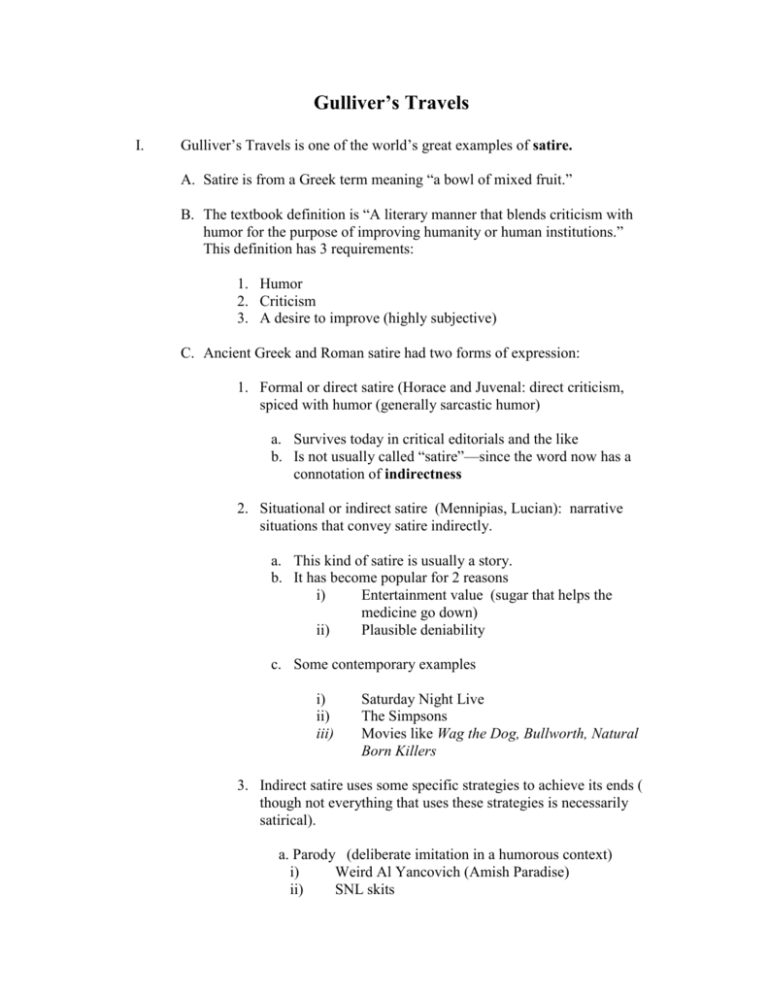
Gulliver’s Travels I. Gulliver’s Travels is one of the world’s great examples of satire. A. Satire is from a Greek term meaning “a bowl of mixed fruit.” B. The textbook definition is “A literary manner that blends criticism with humor for the purpose of improving humanity or human institutions.” This definition has 3 requirements: 1. Humor 2. Criticism 3. A desire to improve (highly subjective) C. Ancient Greek and Roman satire had two forms of expression: 1. Formal or direct satire (Horace and Juvenal: direct criticism, spiced with humor (generally sarcastic humor) a. Survives today in critical editorials and the like b. Is not usually called “satire”—since the word now has a connotation of indirectness 2. Situational or indirect satire (Mennipias, Lucian): narrative situations that convey satire indirectly. a. This kind of satire is usually a story. b. It has become popular for 2 reasons i) Entertainment value (sugar that helps the medicine go down) ii) Plausible deniability c. Some contemporary examples i) ii) iii) Saturday Night Live The Simpsons Movies like Wag the Dog, Bullworth, Natural Born Killers 3. Indirect satire uses some specific strategies to achieve its ends ( though not everything that uses these strategies is necessarily satirical). a. Parody (deliberate imitation in a humorous context) i) Weird Al Yancovich (Amish Paradise) ii) SNL skits iii) Mad Magazine b. Exaggeration (taking a problem and making it seem larger than it is, often by projecting the problem into the future— what would society be like if the trend towards X continues?) i) ii) iii) Computerization: Vonnegut’s Player Piano Absentee Parents: Brave New World Government Surveillance: 1984 c. Defamiliarization: shows our society in an unfamiliar context and then leads us to a shock of recognition. i) ii) Animal Farm “The Nacirema” (Horace Miner) d. Diminution (The opposite of Exaggeration--takes as serious issue and treats it like no big deal. i) ii) II. “Massive Head Wound Harry” Metamorphosis Gulliver’s Travels A. Written by Jonathan Swift (1667—1745) B. One of the world’s greatest examples of satire—almost every kind of satire possible is represented somewhere in the text. C. The Text begins with a conversation in a coffee shop—Swift and all of his friends were talking about how bad modern literature was and they each decided to parody one aspect of it. 1. Alexander Pope—Epic poetry—“The Rape of the Lock” 2. John Gay—light opera—The Beggar’s Opera 3. Swift—the travel narrative—Gulliver’s Travels. The initial point was to parody the wild nature of travel narratives by creating one that was completely impossible and relating it in a scientific, detached, matter-of-fact style. D. Gulliver’s Travels consists of four distinct books 1. The voyage to Lilliput a. Gulliver travels to a land of small people with an intricate political system. b. Main satire = politics (rope dancers, Big-Endians vs. Little Endians, putting out the fire) c. Main devices: Diminution (literally), defamiliarization 2. The voyage to Brobdingnag a. Gulliver meets a race of giants who are also morally superior to humans in every way. b. Gulliver tries to convince them of the value of human Institutions such as war and gunpowder. c. Satire: to see how ridiculous our institutions are when explained in a neutral context. d. Principal device: Utopianism 3. The voyage to Laputa a. Gulliver meets a race of scientists and mathematicians (he is making fun of England’s new Royal Academy of Science). b. Their clothes don’t fit because they have been measured with mathematical calculations. c. They have to have “flappers” to keep them from completely losing their attention d. They perform all kinds of ridiculous experiments with no purpose. e. Satire: the folly of abstract, scientific thinking about concrete human problems. f. Devices: Characterization, Exaggeration III. Book Four A. Book Four is considered Swift’s masterpiece (though Book One is much more famous). B. It is a critique of two different, mutually exclusive, things. 1. Irrationality 2. Rationality C. The main satiric device is defamiliarization: Gulliver encounters a society where the humans (Yahoos) are monstrous beasts and the horses (houyhnhms) are rational. D. The criticism of irrationality is carried through the yahoos 1. 2. 3. 4. 5. 6. 7. 8. 9. Initial description—designed to defamiliarize Yahoos—Human War Weapons Reason makes us dangerous Lawyers Merchants Doctors Politicians E. The criticism of rationality is carried through the Houhnhnyms 1. 2. 3. 4. 5. 6. 7. No salt No difference of opinion Sex is only for procreation Genetic engineering Children taught to work, not play No family affection Contemplate the extermination of Yahoos WHEN they discover the capability of sentience. Gulliver makes them nervous because he suggests that their ordered vision of the world may be flawed 8. Swift’s ultimate suggestion: if humanity were purely reasonable, they would stop being human and would be nothing more than talking horses. F. The criticism of critics is carried through Gulliver—at some point, Gulliver’s rejection of his species and his adoration of the horses becomes irrational and silly. 1. 2. 3. 4. 5. 6. Gulliver becomes a misanthrope Yahoos make him sick He wears Yahoo skin shoes He can’t stand the thought of humans He kills Yahoos (humans) to make his boat He cannot handle the friendliness of Pedro de Mendez, who is an honorable man 7. He ignores his wife and children and talks to his horses G. There is no one target to Swift’s satire—he is equally satirizing a wide variety of targets. Satire is a sort of glass, wherein beholders do generally discover everybody's face but their own. –J. Swift
